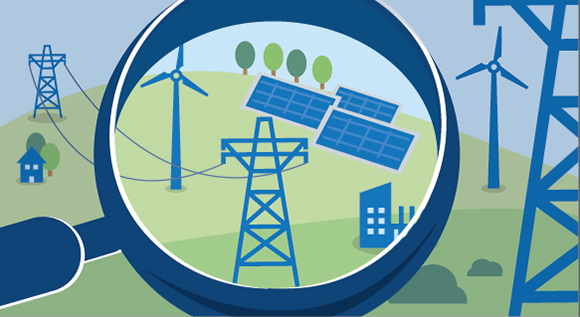What does "uniform pricing" actually mean?
The energy transition is bringing a wave of new jargon into the public realm. This section provides some background on the most important ones, with this week’s edition focusing on "uniform pricing". That is the name of the new procedure to determine the level of funding granted to ground-mounted photovoltaic installations (or "solar farms"). What is the underlying logic, and what distinguishes the new method from the previous approach?
 © BMWi
© BMWiIt’s about auctioning funding for solar farms
The renewable forms of energy have long since matured. So the funding they receive no longer needs to help them enter the market: rather, it is about making sure that they compete on the market. In this context, the Renewable Energy Sources Act reformed the funding system last year, moving away from fixed funding rates towards more competition to determine the level of funding. In the case of solar farms, it is no longer stipulated by law, but is determined via auctions. But in these auctions, the winner is not the highest bid, but the lowest. In other words, funding goes to those who need it least.
The funding process for renewables is basically to be changed to an auction scheme by 2017. Pilot auctions for solar farms are a first step in this direction. The first auction round for ground-mounted PV installations took place in spring 2015. The second was completed in August 2015. The Federal Network Agency will be accepting bids in the third round up to 1 December 2015.
Pay-as-bid versus uniform pricing auctions
During the first round of auctions, prices were still determined using the so-called "pay-as-bid" procedure. Successful bidders were granted funding at the level for which they had bid. The funding level therefore varied from one solar farm to another. In the second and third round, an alternative pricing mechanism is being tested: "uniform pricing".
Under this procedure, the lowest bids win - just as they did under the "pay-as-bid" system. But in this case, the level of funding granted will be the same for all the solar farms which bid successfully. The level of funding will correspond to the highest bid which won funding, and will also be granted to all the other successful bidders. The "uniform pricing" system means that some bidders will receive more funding than they requested in the auction.
Does this automatically mean that the overall amount of assistance will rise for all of the solar farms? This is not the case, as similar auctions in other areas have shown. This is because, under the "uniform pricing" system, the bidders tend to submit bids based on their actual costs. After all, they know that, thanks to the subsequent rise in the funding to the level of highest successful bid, they can still make a profit. In contrast, under the "pay-as-bid" system, the bidders tend to price their future profit into their bid, since this is the "final amount" they would get if their bid is successful. So they actually submit a slightly higher bid. In theory, therefore, both mechanisms produce similar results. Whether this also applies in practice will be shown by the pilot auctions.
It is worth noting that the "uniform pricing" procedure is also used on the EEX European Energy Exchange at Leipzig, which is a trading platform for electricity for the whole of Germany, Austria and France.

